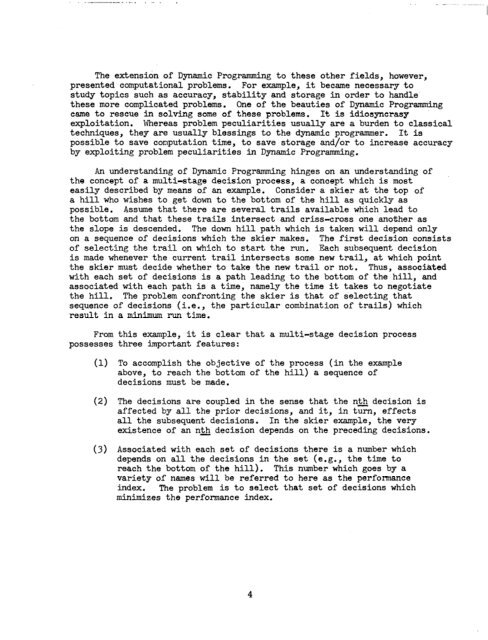guidance, flight mechanics and trajectory optimization
guidance, flight mechanics and trajectory optimization
guidance, flight mechanics and trajectory optimization
Create successful ePaper yourself
Turn your PDF publications into a flip-book with our unique Google optimized e-Paper software.
The extension of Dynamic Programmin g to these other fields, however,<br />
presented computational problems. For example, it became necessary to<br />
study topics such as accuracy, stability <strong>and</strong> storage in order to h<strong>and</strong>le<br />
these more complicated problems. One of the beauties of Dynamic Programming<br />
came to rescue in solving some of these problems. It is idiosyncrasy<br />
exploitation. Whereas problem peculiarities usually are a burden to classical<br />
techniques, they are usually blessings to the dynamic programmer. It is<br />
possible to save computation time, to save storage <strong>and</strong>/or to increase accuracy<br />
by exploiting problem peculiarities in Dynamic Programming.<br />
An underst<strong>and</strong>ing of Dynamic Programming hinges on an underst<strong>and</strong>ing of<br />
the concept of a multi-stage decision process, a concept which is most<br />
easily described by means of an example. Consider a skier at the top of<br />
a hill who wishes to get down to the bottom of the hill as quickly as<br />
possible. Assume that there are several trails available which lead to<br />
the bottom <strong>and</strong> that these trails intersect <strong>and</strong> criss-cross one another as<br />
the slope is descended. The down hill path which is taken will depend only<br />
on a sequence of decisions which the skier makes. The first decision consists<br />
of selecting the trail on which to start the run. Each subsequent decision<br />
is made whenever the current trail intersects some new trail, at which point<br />
the skier must decide whether to take the new trail or not. Thus, associated<br />
with each set of decisions is a path leading to the bottom of the hill, <strong>and</strong><br />
associated with each path is a time, namely the time it takes to negotiate<br />
the hill. The problem confronting the skier is that of selecting that<br />
sequence of decisions (i.e., the particular combination of trails) which<br />
result in a minimum run time.<br />
From this example, it is clear that a multi-stage decision process<br />
possesses three important features:<br />
(1) To accomplish the objective of the process (in the example<br />
above, to reach the bottom of the hill) a sequence of<br />
decisions must be made.<br />
(2) The decisions are coupled in the sense that the ntJ decision is<br />
affected by all the prior decisions, <strong>and</strong> it, in turn, effects<br />
all the subsequent decisions. In the skier example, the very<br />
existence of an n4fi decision depends on the preceding decisions.<br />
(3) Associated with each set of decisions there is a number which<br />
depends on all the decisions in the set (e.g., the time to<br />
reach the bottom of the hill). This number which goes by a<br />
variety of names will be referred to here as the performance<br />
index. The problem is to select that set of decisions which<br />
minimizes the performance index.

















